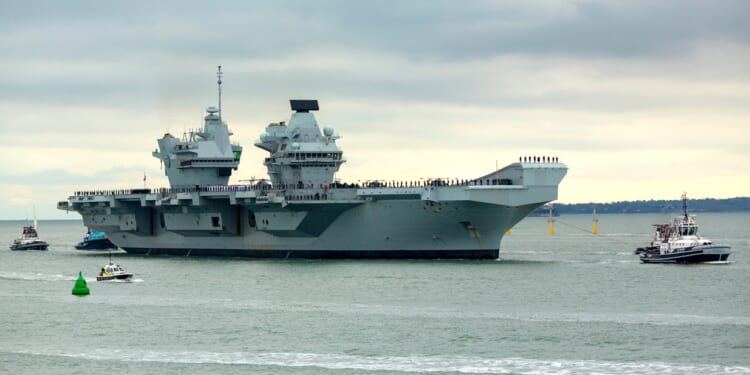The older Prince of Wales was sunk by Japanese aircraft in December 1941. In the modern age, it faces a new enemy: looters intent on plundering its valuable low-background steel.
The Royal Navy’s flagship aircraft carrier, HMS Prince of Wales, has concluded its deployment in the Pacific Ocean and has begun its long return trip home, marking the final leg of “Operation Highmast.” On Friday, the warship’s crew and other officials also took a moment to pay respect to another HMS Prince of Wales—the King George V-class battleship that was sunk along with the battlecruiser HMS Repulse on December 10, 1941, off the coast of the Malay Peninsula by land-based Japanese aircraft.
That event marked the first time that a battleship at sea was sunk solely by aircraft. At the time, the sinking was described in the British press as a calamity, and presaged the fall of Singapore to the Japanese—the worst military defeat in British history—two months later.
Six Japanese sailors participated in Friday’s ceremony, underscoring the close ties that now exist between London and Tokyo.
“Committal wreaths were placed in the sea by UK Commander Carrier Strike Group, Commodore James Blackmore, Commanding Officer of the aircraft carrier, Captain Will Blackett, and Sub Lieutenant Takumi Kitamura from the accompanying Japanese destroyer Akebono,” the Royal Navy announced.
“It’s an opportunity to pause in the middle of our operations to lead this ship’s company of 1,600 people in an act of commemoration on the site of the ship that we’re the continuation of,” Mark Mander, the chaplain of the current HMS Prince of Wales, told The Times newspaper. “It shows everyone that should we ever go into conflict, we have a legacy — and we remember those who made this sacrifice. And it shows that the sacrifice was not in vain, because here we are, a British ship with Japanese sailors on our flight deck, a demonstration that reconciliation works.”
The Loss of Force Z
To counter Japanese aggression in the Far East, Prime Minister Winston Churchill ordered Force Z, consisting of the brand-new battleship HMS Prince of Wales and the World War I-era battlecruiser HMS Repulse, to be sent to Singapore to bolster the island’s defenses. Just days after arriving in the region, they were dispatched to locate a Japanese force that was reported to be landing on the Malay Peninsula.
Failing to engage the enemy, the two British warships were returning to Singapore when they came under attack from Japanese aircraft. Lacking air cover, Force Z put up a strong defense, but both ships were lost.
HMS Repulse went down with 512 sailors and officers, while HMS Prince of Wales saw 330 lost, including Admiral Tom Phillips, commander of Force Z, and the battleship’s command officer, Captain John Leach.
“In all the war, I never received a more direct shock,” Churchill later wrote, of being woken up to be told the news of the loss of the same battleship that had carried him across the Atlantic Ocean just months earlier. “Across this vast expanse of waters, Japan was supreme, and we everywhere were weak and naked.”
The Sunken Warships Have a New Enemy: Looters
The wreck site of the two British warships has been looted in recent decades by salvage operators, who seek the valuable metals contained within—particularly the “low-background steel” of the ships’ hulls, which was produced before the detonations of the first atomic bombs in 1945 and therefore lacks the background radiation found in all modern steel.
Low-background steel is needed for use in sensitive medical and scientific equipment, and can therefore be highly lucrative to pilfer. In May 2023, Malaysian authorities seized a Chinese salvage vessel that was reportedly looting the two iconic shipwrecks.
As a result of the concerns that scrappers and souvenir hunters would plunder the ship, 20 years ago, Royal Navy divers recovered the ships’ bells and returned them to the Royal Navy Museum in Portsmouth, England.
The New Prince of Wales Has a Long Journey Home
Operation Highmast commenced in April with the carrier’s departure from Portsmouth, England, and Carrier Strike Group 2025 (CSG25) is now expected to be home for Christmas.
The deployment has highlighted the Royal Navy’s future, including its expanded role in the security of the Indo-Pacific. That mission has largely been accomplished, as it is also the third NATO carrier to make the journey to the region and back, following that of the Italian Navy’s flagship, ITS Cavour, last year and France’s flagship, FS Charles de Gaulle, this past winter.
About the Author: Peter Suciu
Peter Suciu has contributed over 3,200 published pieces to more than four dozen magazines and websites over a 30-year career in journalism. He regularly writes about military hardware, firearms history, cybersecurity, politics, and international affairs. Peter is also a contributing writer for Forbes and Clearance Jobs. He is based in Michigan. You can follow him on Twitter: @PeterSuciu. You can email the author: [email protected].
Image: Shutterstock / David Peter Robinson.


















